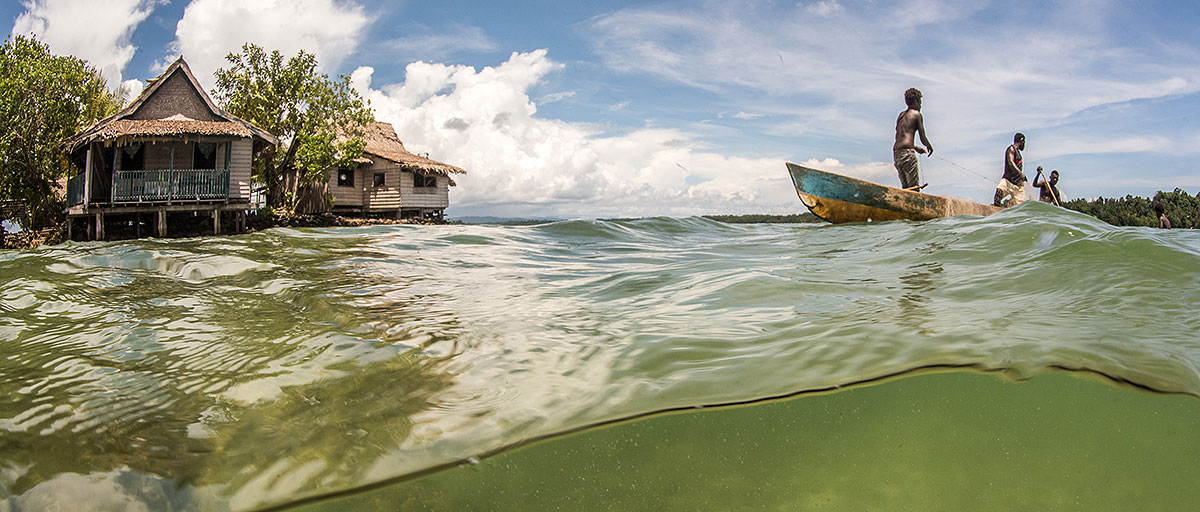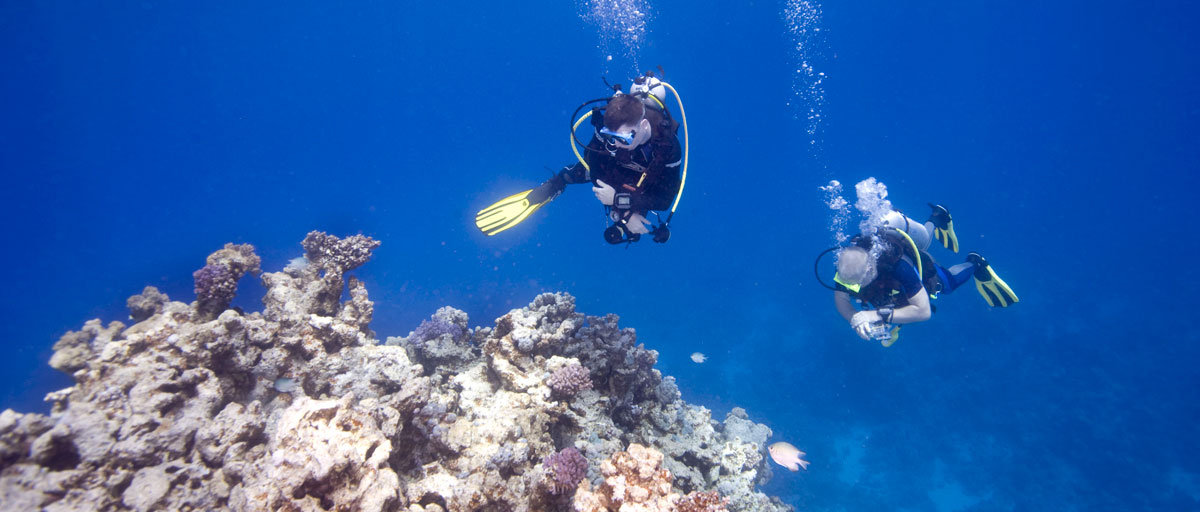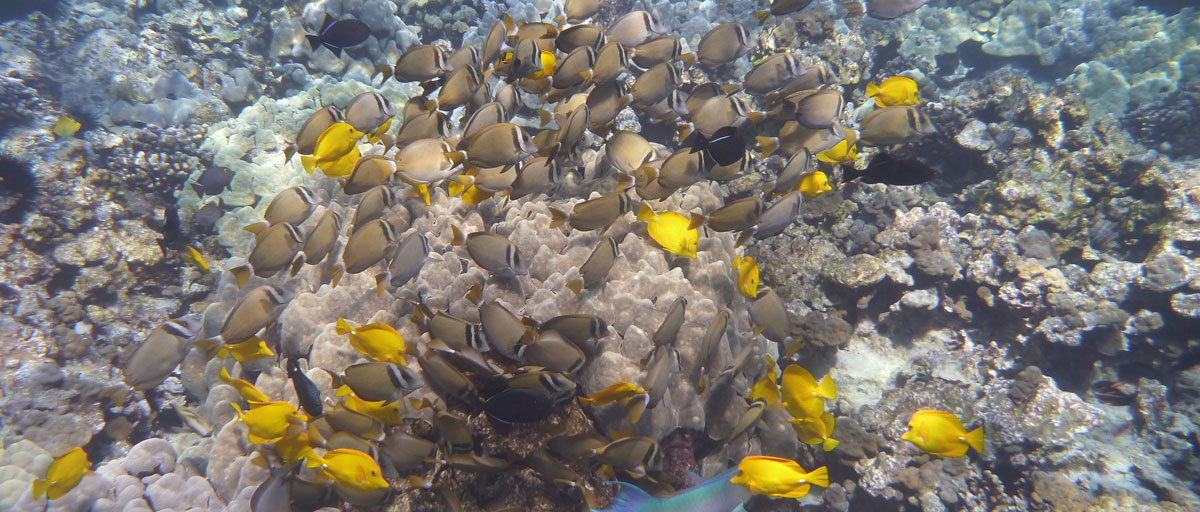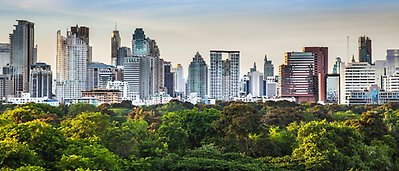Bildtext får vara max två rader text. Hela texten ska högerjusteras om den bara ska innehålla fotobyline! Photo: B. Christensen/Azote
CORAL REEFS
Human settlements make coral reefs react unpredictably to climate change

In a paper published in Frontiers in Marine Science, researchers show that being close to larger human populations changes the relationships between coral reefs and their biophysical environment. Photo: T. Vierus/Pacific Media House
- Thermal anomalies, unusual weather patterns and destructive storm events associated with a changing climate are increasing
- Local human impacts alter the way natural systems like coral reefs respond to these changes
- Projecting climate change impacts may be particularly challenging at reefs close to higher human populations
Life on land affects communities at the bottom of the ocean
NOT COMFORTABLE AROUND PEOPLE: Coral reefs support half a billion people yet they are severely compromised by human activity.
To plan ahead with appropriate conservation measures, scientists have developed models to understand how reefs respond to increasingly common climate change-related events such as unusual weather patterns or destructive storms.
But given that more than half the world’s coral reefs are located in close proximity to human settlements, it is important to examine how different densities of human populations affect reef health and responses to climate change.
The risks of human proximity
Research has shown that coral reefs can be compromised close to human populations - for example macroalgae can overtake corals as the dominant organisms - but it is also important to understand the interplay between these ‘local impacts’ and climate change.
In a paper published in Frontiers in Marine Science, former centre researcher Amanda Ford, now at the University of the South Pacific, shows that being close to larger human populations changes the relationships between coral reefs and their biophysical environment.
The study was published together with SRC colleagues Jean-Baptiste Jouffray, Albert Norstrom and an international team of researchers.
They call for this to be taken into account when modelling the future of these tropical ecosystems in the face of climate change, as reefs closer to larger populations seem to become less predictable.
It is particularly important for researchers and planners to maximise the ability of models to predict ecosystem futures to allow for appropriate mitigation strategies.
Amanda Ford, lead author
Density of humans has an impact
Increasing sewage input, agricultural run-off, and sedimentation are all associated with higher human densities, reducing water quality and affecting communities at the bottom of the ocean.
Added to this, fishing removes species which play an important role in regulating coral reef communities.
Using data from the Pacific Community (SPC) on underwater surveys of 62 reefs in 17 different Pacific Island countries and overseas territories, the authors ran models with various combinations of environmental predictors to test how well they could predict reef structure, for example the cover of coral and different algal groups.
They found that whilst physical predictors (e.g. depth, latitude, storm exposure) were strong at explaining reef composition at reefs close to small human settlements, their ability to predict reef composition at reefs close to relatively denser populations was severely compromised.
At these more locally-impacted reefs, local features related to human activities (e.g. distance to closest market, biomass of herbivorous fish) emerged as better predictors, suggesting humans had become the dominant driver of reef structure.
The study indicates that species homogenisation may be occurring in reefs that are more exposed to local human impacts, as species are selectively removed by human-associated stressors and only less stress-sensitive species are left in the mix.
Ultimately, these changes lead to reefs becoming ‘decoupled’ from their biophysical environment, and reacting fundamentally differently and unpredictably compared to reefs less influenced by humans.
“Reefs close to human populations will require context-specific management to ensure their future sustainability and associated critical ecosystem services,” conclude the authors.
Video: Amanda Ford explains why the central insights from this study
Methodology
"To ask how local human impacts affect reef configuration and the relationship between reef configuration and environmental predictors, the researchers utilised a large-scale dataset collected by the Pacific Community (SPC) that has unique site-level ecological and socio-economic data across 17 different Pacific Island countries and territories. Importantly, all reefs were in close vicinity to, and used by, coastal human communities.
Field surveys collected data on reef depth, benthic assemblages, and herbivorous fish communities, and additional data on thermal stress, storm exposure, and market gravity (a function of human population size and reef accessibility) were extracted from public repositories.
The researchers then used a combination of pre-defined explanatory models and model selection tools to quantify how well different environmental predictors can explain reef configuration at sites with different levels of local human impacts."
Ford, A.K., Jouffray, J-B., Norström, A.V., Moore, B.R., et.al. 2020. Local Human Impacts Disrupt Relationships Between Benthic Reef Assemblages and Environmental Predictors. Front. Mar. Sci., 21 October 2020 | https://doi.org/10.3389/fmars.2020.571115
For more information about the study, please contact co-authors Jean-Baptiste Jouffray and Albert Norström:










